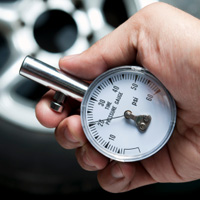The Inflation of Tyres
The air pressure for a new tyre should be set in accordance with the vehicle manufacturer’s specifications, if the tyre is the same size as the size original installed by the manufacturer. The vehicle manufacturer’s recommendation can usually be found in the owner’s manual or on a sticker on the door jamb (side of the door or door pillar). Vehicle placard inflation would be the exact recommended inflation by manufacturer. No more, no less.
It is very important to maintain proper tyre pressure. Under-inflated tyres can lead to excessive heat build-up and structural stress which can cause a tyre to fail. Over-inflation can cause uneven tyre wear in the centre portion of the thread pattern and lead to vehicle handling problems.
The tyre pressure should not be checked after the vehicle has been operated because tyres heat up, causing the air pressure to rise. Allow time for them to cool and then perform your check.
It is also important that your spare tyre is checked as well. The proper air pressure for a spare is often different from the tyres mounted on your vehicle. The proper air pressure for your spare should also be listed in the owner’s manual or on the door jamb.
Use a quality air gauge when checking the pressure (digital gauges are the most reliable) or have a professional service technician do the work for you.
Maintaining proper tyre pressure will also contribute to better fuel efficiency – So check, be safe and save!
With Pirelli Connesso you can have the data at your palm.
